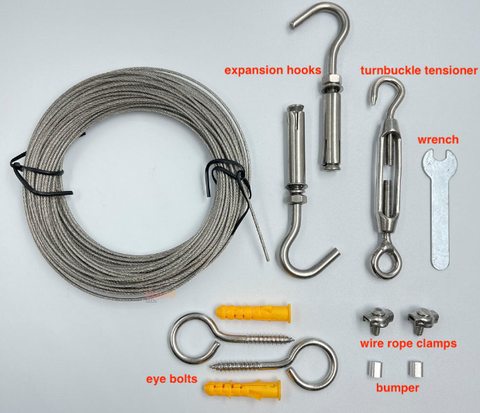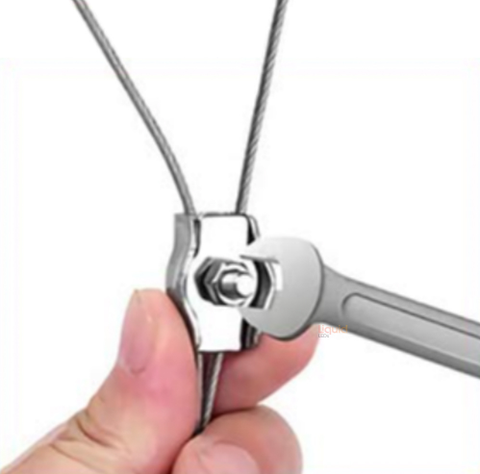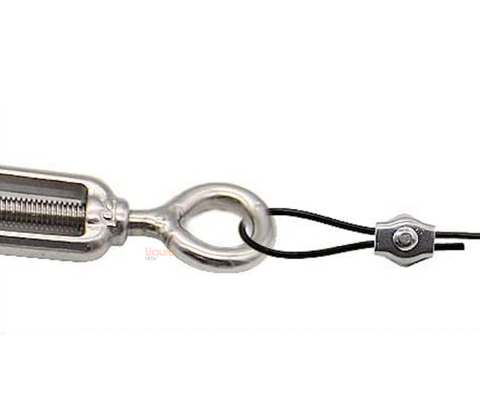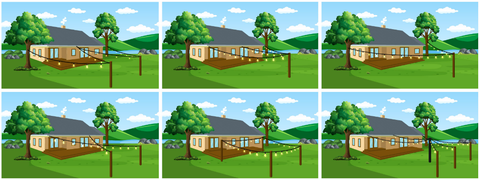Want to hang festoon lights outdoors but are not sure how to go about it? Don’t worry, we have your back. Contrary to what many think, you don’t need any fancy tools or put in a lot of effort to install festoon lights in your backyard or patio. Use this guide as a referencing material, and we promise you’ll be able to this without any hitch.
The secret to hanging festoon lights outdoors is to know what materials and tools to use and how to set them up with trees or without them. Also, keep in mind that no two outdoor locations are identical, so at times you might need to think a little out of the box. That said, our Festoon hanging kit has all the tools and materials you may need to hang festoon lights outdoors, regardless of its uniqueness.
The kit includes a stainless steel cable, two expansion hooks, two eyelet screws with plastic expansions, a turnbuckle, two wire rope clamps, two adjustable locking devices, and a wrench. As the image below shows, it has everything you may need to install the festoon lights, even over a long distance.

Materials and Tools Needed
Depending on how and where you wish to hang the festoon lights, you will need various materials and tools,. For example, hanging them outdoors without trees is very different from suspending them from a pergola. Shared ahead are the three most installation situations:
Stringing Festoon Lights With Fixed Points That Are Closer Than 8m
- Festoon Lights: Ensure the festoon lights you have can sufficiently cover the entire length of the selected area.
- Extension Cord (Outdoors): Unless the exterior electrical outlet is very close to the location where you wish to hang the festoon lights, you will need an extension cord meant for outdoor use.
- Drills: Ideally, you may want to use electrical drills. If you don’t have them, the other alternative is manual drills.
- Tape Measure: You will need it to measure the distance between the hookup points.
- Painter’s Tape/Pencil: You can use either for the purpose of marking spaces.
- Eye Bolts/Metal Hooks: You will need them for anchoring. Eyebolt is used for timber surfaces. It is used with a plastic anchor on brick or concrete. The expansion hooks are another option.

- Wire Rope Clamps: You will need them to connect two cables together or to form a wire rope eye.

- Turnbuckle Tensioner: This is needed for adjusting tension and reducing slack in a cable or rope.

- Ladder: You are likely to need a ladder if you are setting up the festoon lights farther from to the ground.
Stringing Festoon Lights With Fixed Points That Are More Than 8m Apart
If you are hanging the festoon lights over a large area, you will need:
- String Light Suspension Kit: With our kit, you can easily support the festoon lights over a large area. The kit includes a stainless steel cable, two expansion hooks, two eyelet screws with plastic expansions, a turnbuckle, two wire rope clamps, two adjustable locking devices, and a wrench. In short, it has everything you need to expertly hang the festoon lights.
- Wire Cutter: It allows you to trim the cable so that it perfectly fits. Keep in mind you should shorten your wire cable only after completing the installation. Otherwise, you may end up with a cable whose length is not sufficient for your needs.
Stringing Festoon Lights When There Are No Trees or Tall Supports
How to hang the string lights in a backyard without trees or tall supports? This is one question we get asked a lot. The installation itself is quite simple, but you are going to need some extra materials and tools..
Here are some other things you are likely to require if you want to light up an outdoor space devoid of trees or tall supports.
- Wooden Poles/Posts: In the absence of any tall supports, you can use wooden poles or posts. So, what is the ideal height? Well, this depends on your personal preferences. However, you may not want to install the lights more than 30 meters up, because then you may not get the desired effect.
- Nails: They can come handy when attaching lights to an outdoor fence.
- Hammer: If you plan to use nails, a hammer is required.
- Weighted Buckets: You will need these for weighing down the base and securing the lights against wind. You can find weighted buckets in different varieties, though in most situations, using plastic buckets that are filled with concrete work absolutely fine. You will need one weighted bucket for each post.
Steps for Hanging Festoon Lights
Here are the steps you need to follow to install festoon lights.
- Create a lightening layout and plan the fixing points
First things first, plan the lighting layout, which includes figuring out where the fixing points are going to be installed. The advantage of visualizing the project before starting is that you will then know exactly how much lighting are going to need.
While you are at it, decide the lighting pattern. Most people prefer to use the V, X, pinwheel, or parallel pattern, but you can create any pattern you want. While visualizing a pattern, pay attention to the fixing points to ensure they will be able to aptly support the desired pattern. Tall trees are excellent fixing points, as are the side of homes and fence posts.

Sometimes, people have difficulty with those fixing points that are quite a distance away from their home. However, this problem can be solved using wooden posts. They are not only easy to install but also give you more options as far lighting patterns are concerned. The fixing points, ideally speaking, should not be more than 8m apart; otherwise, you will have to use supporting wires.
- Install the fixing points
Your choice of pattern design determines the kind of fixing points needed. That said, eyes or metal hooks work fine for most people.
It’s important you close the fixing points. Else, there is a risk of the cable coming off hooks, especially if you live in a windy area. That’s why drilling holes for your hooks and then screwing them into place one by one. You may use adhesives for extra protection, but most surfaces don’t require them.
- Attach the festoon lights to the fixing points
Cable ties help to attach the festoon lights firmly to the fixing points or supporting wire. Once the support lines are up, this is a pretty straightforward process.
If the distance between two fixing points is less than 5m apart, you don’t need support wire but we highly recommend. You can simply install them to your fixing points. Make sure the power cord is snug closely against the ground or wall. This will minimize the risk of someone accidentally tripping over it.
- Screw-in the bulbs and turn on the power
Simply screw all the LED light bulbs into their sockets and turn the power on.
Steps to hang the Festoon Lights without Trees
If your backyard has no trees or other support points, don’t worry. You can still achieve the landscape of your choice if you are a little creative. Here are some useful tips.
Set up the festoon lights upon a fence
Attaching wooden posts (3m) to a fence using cup hooks and side nails is a great idea if you don’t have any trees or support points. Since fences are generally well-grounded, you should have no trouble in securing the festoon lights.
Hang the festoon lights under a covered patio or pergola
Perhaps the simplest way is to hang the festoon lights under a covered patio or pergola. Just attach the cup hooks rough a meter apart under such a structure to create any kind of design you want.
Conclusion
Successfully installing festoon lights is easier than you may think and starts with planning. Work out the pattern you like best and the fixed points — and you are good to go. With a thorough planning, you can hang string lights from practically anywhere.
